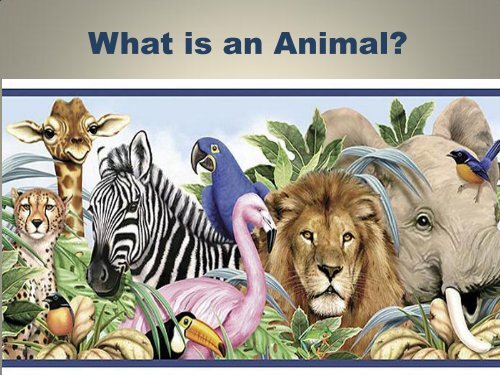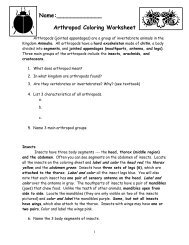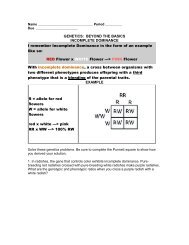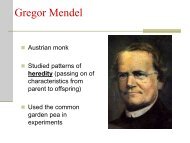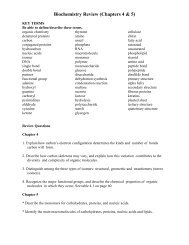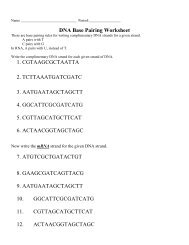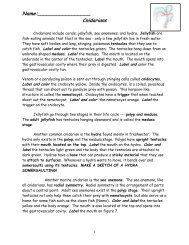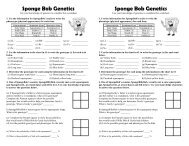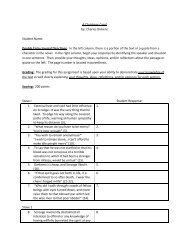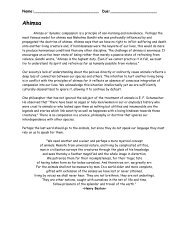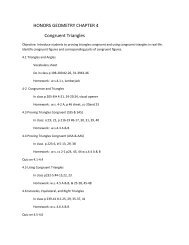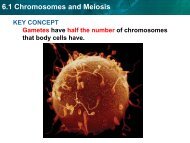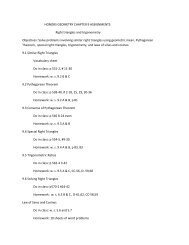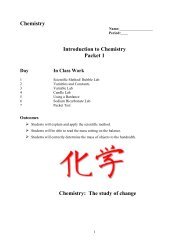What is an Animal PPt
What is an Animal PPt
What is an Animal PPt
- No tags were found...
You also want an ePaper? Increase the reach of your titles
YUMPU automatically turns print PDFs into web optimized ePapers that Google loves.
T<strong>is</strong>sues• A group of similar cells thatperform a specific function in <strong>an</strong><strong>an</strong>imal
Types ofT<strong>is</strong>sues• Nervous t<strong>is</strong>sue:• carries electrical• signals from one• part of the body to• <strong>an</strong>other• Bone t<strong>is</strong>sue: A hard• t<strong>is</strong>sue that gives bones• their strength
Org<strong>an</strong> System• A group of org<strong>an</strong>s that worktogether to perform a morecomplex function
Functions of <strong>Animal</strong>s• <strong>Animal</strong>s are very diverse– Size– Structure– Appear<strong>an</strong>ce– All carry outthe samebasic functions
Major Functions of <strong>Animal</strong>s• Obtain food• Obtain Oxygen(O2)• Keep Internal conditions stable• Move• Reproduce
Obtaining Food <strong>an</strong>d Oxygen• <strong>Animal</strong>s are not autotrophs– c<strong>an</strong> not make their own food• Must obtain food– Heterotrophs
Food provides<strong>an</strong>imals withraw materials– for growth– For activities• Breathing• Moving• Digestion• Oxygen allowsthem to releaseenergy from food
Food Acqu<strong>is</strong>ition• <strong>Animal</strong>s acquire food in three ways– Herbivores– Eat pl<strong>an</strong>ts
• Eating other org<strong>an</strong><strong>is</strong>ms– Carnivores• Hunters• Predator <strong>an</strong>d Prey
Decomposers• Break down org<strong>an</strong>ic materials
Scavengers• Eat dead <strong>an</strong>d dying org<strong>an</strong><strong>is</strong>ms
• Omnivore–Eats pl<strong>an</strong>ts–<strong>an</strong>d <strong>an</strong>imals
Keeping conditions stable• <strong>Animal</strong>s must maintain a stableenvironment in their bodies–Cells die if too hot–Or to cold
• ColdbloodedE c t o t h e r m
Endotherm• Warm blooded• <strong>Animal</strong> whose body regulates itown temperature• Controls the internal heat itproduces
Movement• All <strong>an</strong>imals move in some wayduring their life• Required for <strong>an</strong>imals to meet thebasic needs– Survival– Reproduction
Types of movement• Walk,• hop,• crawl• Swim• Fly
Reproduction• Necessary for the continuation ofthe species• May occur in two ways– Sexually-A new org<strong>an</strong><strong>is</strong>mdevelops from the joining of twocells• Egg- Female sex cell• Sperm- Male sex cell
FertilizationEgg <strong>an</strong>dspermcell join tocreate <strong>an</strong>eworg<strong>an</strong><strong>is</strong>m
Asexual Reproduction• The process by which a singleorg<strong>an</strong><strong>is</strong>m produces a neworg<strong>an</strong><strong>is</strong>m identical to itself–Budding
Classification of <strong>Animal</strong>s• Scient<strong>is</strong>ts have sorted <strong>an</strong>d divided<strong>an</strong>imals into 35 groups known asPhylums• <strong>Animal</strong>s are• classified• according tohow they arerelated toother <strong>an</strong>imals
Determined by :• <strong>Animal</strong>s body• structure• The way <strong>an</strong> <strong>an</strong>imal develops• DNA
Vertebrates–<strong>Animal</strong>s with a backbone
Invertebrate<strong>Animal</strong> without a backbone97% of all <strong>an</strong>imals fall into th<strong>is</strong>category
<strong>Animal</strong> SymmetryThe bal<strong>an</strong>ced arr<strong>an</strong>gement ofparts
Bilateral SymmetryOne line dividing into two mirrorimages
Character<strong>is</strong>tics of <strong>Animal</strong>s withBilateral Symmetry• Larger• More complex• Front end• Move more quickly• <strong>an</strong>d• efficiently• Streamlined body• Sense org<strong>an</strong>s– Located in front end– Pick up information– about environment
Radial SymmetryEqually spaced around a centralpoint
Character<strong>is</strong>tics of <strong>Animal</strong>s withradial symmetry• No d<strong>is</strong>tinct front or back end• All of them live in water• Most do not move very fast–Stay in one spot–Are moved by water currents–Creep along the bottom


